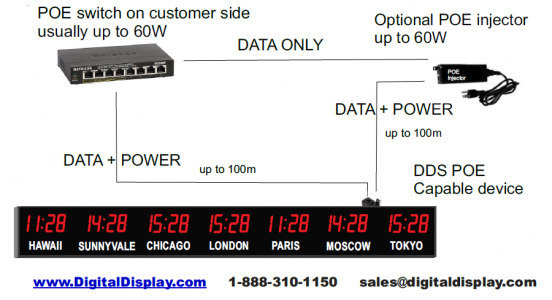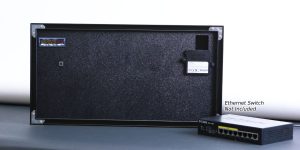Ethernet/NTP 2.5" Master Clock: MNP-25 – $489
MNP-25 Features
- Master clock with NTP sync and switch button controls on back
- Each clock has its own unique MAC address and IP address
- Includes 15 feet RJ45 Cat5E Ethernet Cable and mounting hardware
- RS485 cable for wired connection to secondary clocks
- Optional RF wireless connection to secondary clocks available
- 10 year lithium battery backup of memory in case of power outage
- Bright red 2.5" height digit display with 1.8" seconds
- Other available sizes: 1.8", 4", and 7"
- Other available colors: Blue and Green (additional pricing)
- Contact Sales about Power over Ethernet (PoE) capabilities
Network Time Protocol (NTP) is a networking protocol for clock synchronization between computer systems over packet-switched, variable-latency data networks. In operation since before 1985, NTP is one of the oldest Internet protocols in current use. There are multiple public time servers available from government agencies as well as public companies, that allow a “ping” time request sent to them every ~ 5 minutes. NTP accuracy is ~ 100 milliseconds.
The DDS NTP master clock can be pointed to either a local time server or a public time server and use the signals to correct its own internal clock. The master has its own backup battery and keeps a very accurate time of its own. The master will send a packet of time to all the secondary and keep them synchronized to its own clock, thus saving maintenance time and keeping everyone in your organization on the same time. The master can be adjusted to a specific time zone and day light savings, and will adjust automatically with the DST changes of the selected region.
Our Master clock can connect to other secondary clocks via a wired connection or RF wireless connection.
Public NTP Time Servers
View a list of public time servers curated by the National Institute of Standards and Technology (NIST) Internet Time Service.
Power Over Ethernet
PoE (Power over Ethernet) is gaining popularity as a cost-saving measure, allowing customers to reduce the cost of AC outlet installations . In recent years PoE has improved significantly and now allows up to 60W per port. POE can deliver power of up to 100 meters, and with some power injectors, up to 200 meters. Most POE’s will run on ~45-55v DC to allow voltage degradation over large distance, while the end device will reduce it to its required voltage of 5-24 volts. Installers will need to calculate the power required to run multiple devices on the same line and add POE injectors as required.
DDS displays, clocks and timers allow you to power our devices using POE enabled switch or using POE injector. Using DDS NTP synchronization also allows both low power and automated time synchronization to your network time server of your choice. In a typical installation, the customer must have a POE switch or POE injector that can feed DDS devices.
Small standalone clocks are:
15 watts (IEEE802.3AF STD) POE.
Small vinyl clocks are:
30 watts (IEEE802.3AT STD) POE.
Larger clocks are:
60 watts (IEEE802.3BT STD) POE.
If you are looking for PoE-enabled clocks, please confirm you have a PoE switch or injector that can handle the necessary requirements and standards.






